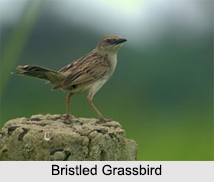 The Indian Subcontinent provides suitable habitats to various species of birds for residing and nesting. Grassbirds are no exception in this regard. Bristled Grassbird and Broad-Tailed Grassbird are the two grassbirds which have been recorded in India. They belong to the kingdom, Animalia; phylum, Chordata; class, Aves; order, Charadriiformes; and family, Locustellidae. These grassbirds are described below.
The Indian Subcontinent provides suitable habitats to various species of birds for residing and nesting. Grassbirds are no exception in this regard. Bristled Grassbird and Broad-Tailed Grassbird are the two grassbirds which have been recorded in India. They belong to the kingdom, Animalia; phylum, Chordata; class, Aves; order, Charadriiformes; and family, Locustellidae. These grassbirds are described below.
Bristled Grassbird
The scientific name of Bristled Grassbird is C. Striata. This bird has mainly been traced in the northern part of the Indian Subcontinent and is endemic to India. The bird has strong black colored bill with the lower mandible tipped bluish grey. Its tarsus is brown colored and supercilium is buff. The feature of the bird which stands out is a bare patch of skin in front of the eyes. On this patch, a vertical row of five stiff rictal bristles arise and face forward. This part of the bird is known to protect the eyes when it forages through dense grass. This large bird is brownish in appearance. There are broad dark streaks on the feathers of the crown and back. The bird has stiff feathers on the breast and in some the tips are dark. Its underside is pale and unmarked. The tail of the bird is graduated with white tips to the feathers. The rachis of the tail feathers can be described as dark and there are dark ribs to the feathers. Male and female birds are known to be similar.
Broad-Tailed Grassbird
The scientific name of Broad-Tailed Grassbird is S. Platyurus. In India, Broad-Tailed Grassbird is endemic to the Western Ghats. More specifically, it is restricted to grassy moist highlands, mainly in the Western Ghats. Some records also support their occurrence in Lonavla and Nasik. This large, plain grass bird has uniform brown upperparts and whitish underparts. The bird has narrow and pale supercilium. The color of its tail is brown and has thin dark bars. The underside of the tail is very dark and the feathers are tipped in white. In terms of plumage, it is difficult to tell the male and female apart. However, it is important to note that the gape color of the male bird is black, whereas that of the female is brown.











